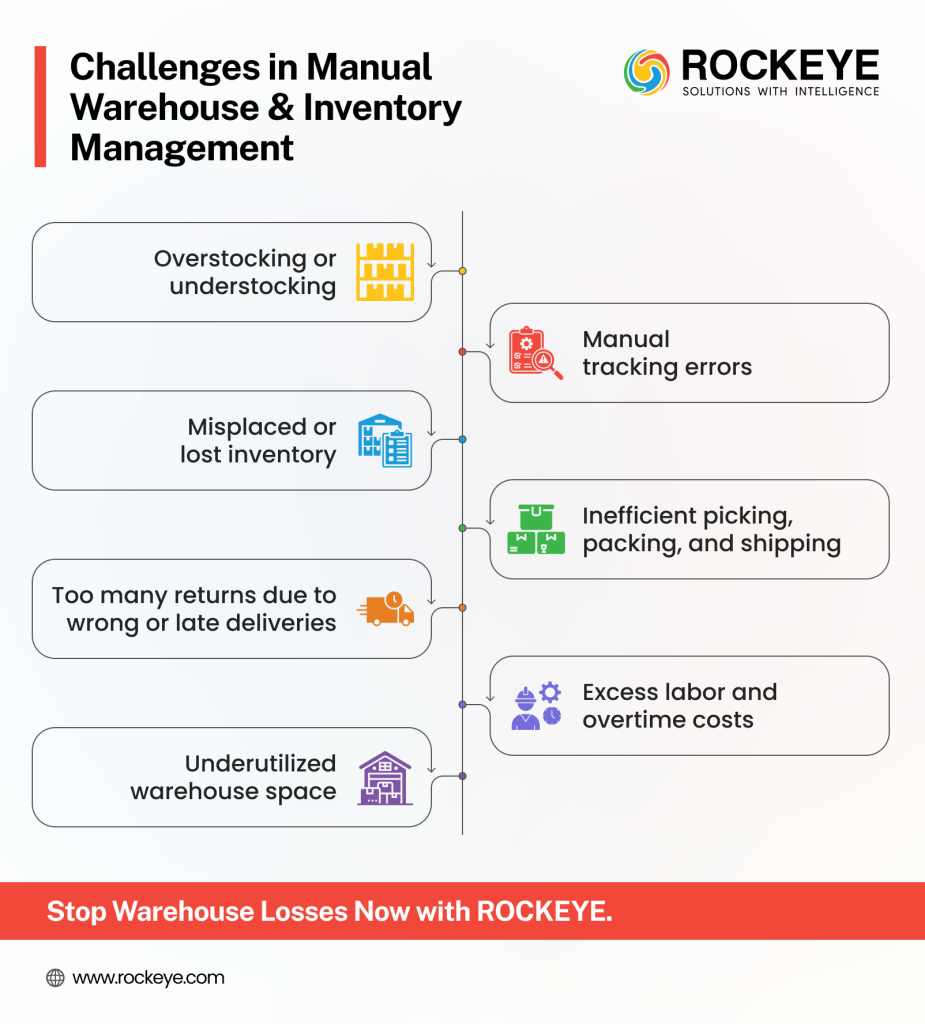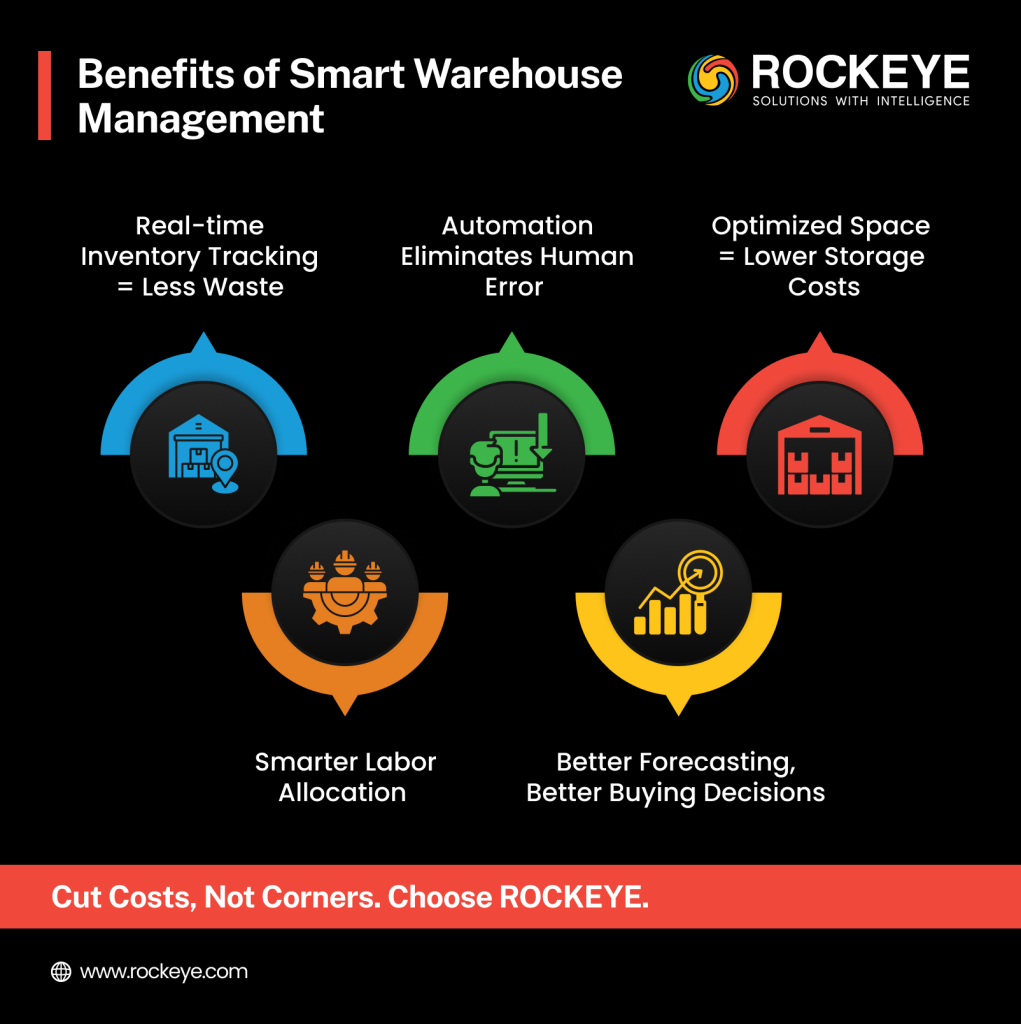Summary:-
Using the right warehouse inventory management software can reduce operational costs by up to 40%. It improves inventory accuracy, reduces manual errors, and automates stock tracking. This boosts efficiency, speeds up order fulfillment, and cuts labor costs. Real-time data enables better demand forecasting and inventory optimization, preventing overstocking and stockouts. Additionally, enhanced visibility and streamlined workflows improve resource allocation and customer satisfaction. Overall, such software drives cost savings and operational excellence in warehouse management.
What if I told you that your warehouse could be the biggest cost-saving engine in your business?
Sounds far-fetched?
Here’s the truth: Businesses that have optimized their warehouse inventory management software have reported up to 40% reductions in operational costs without cutting staff or compromising service quality.
In a world where supply chains are increasingly volatile and customer expectations are sky-high, having the right tools isn’t just an advantage; it’s a necessity.
Let’s dive deep into how warehouse inventory management system software and a modern inventory management solution can transform your operations from a money pit into a well-oiled machine that fuels growth and cuts waste.

Why Do Warehouses Bleed Money in the First Place?
Before we jump into solutions, let’s ask the obvious:
Where is the money being wasted in the first place?
Here are the usual suspects:

Overstocking or Understocking
When you order too much, inventory sits idle, tying up capital and taking up space. Too little? You risk stockouts, missed sales, and unhappy customers. Without a smart inventory management solution, it’s hard to find the right balance, and every mistake eats into your bottom line.
Manual Tracking Errors
Still using spreadsheets or handwritten logs? Manual processes are error-prone. One wrong digit can lead to miscounts, shipment issues, or stockouts. Warehouse management systems automate tracking to reduce these costly errors and give you real-time inventory visibility.
Misplaced or Lost Inventory
When items go missing inside your own warehouse, it’s not just frustrating, it’s expensive. Wasted time, delayed orders, and emergency reorders pile up quickly. A warehouse management system helps you track every item’s location so nothing gets “lost” on the shelf again.
Inefficient Picking, Packing, and Shipping
Slow or disorganized fulfillment kills productivity. If your staff spends too much time finding items or fixing mistakes, your operating costs skyrocket. A smart warehouse solution can optimize picking routes, pack orders faster, and ensure accurate, timely deliveries.
Too Many Returns Due to Wrong or Late Deliveries
Incorrect or delayed deliveries often trigger returns and customer complaints, hurting your brand and draining profit. A reliable inventory management solution ensures you ship the right product, on time, with clear tracking at every step to reduce costly returns.
Excess Labor and Overtime Costs
Hiring more staff to fix process issues? That’s like putting a bandage on a broken system. Poor workflows often mean teams work overtime just to catch up. With automation, smarter workflows, and better data, you can do more with less.
Underutilized Warehouse Space
You might have more storage than you need or not enough because products aren’t stored efficiently. That’s wasted money and a missed opportunity. A warehouse management system helps you use every square foot wisely with optimized layout and real-time space tracking.
If any of these sound familiar, your warehouse is leaking money, fast.
Also Read: Key benefits of inventory visibility
Do You Know?
Small to mid-sized businesses either don’t track inventory at all or use a manual process like Excel or pen and paper.
The result?
Thousands of dollars are lost in write-offs, inefficiencies, and unhappy customers.
The 40% Cost-Saving Blueprint: What the Right System Does Differently
Let’s break down exactly how the right warehousing and inventory management software works its magic.

1. Real-time Inventory Tracking = Less Waste
No more counting stock manually or guessing what’s on the shelf.
With real-time tracking:
- You always know what you have, where it is, and how fast it’s moving.
- It reduces stockouts, overstock, and unnecessary purchases.
- Your team wastes less time searching for items.
Estimated Savings: 10-15% reduction in inventory carrying costs
2. Automation Eliminates Human Error
Manual data entry? Mislabeling? Wrong shipments?
A smart warehouse inventory management solution automates:
- Order processing
- Barcode and RFID scanning
- Pick-pack-ship workflows
- Inventory reconciliation
The result? Fewer returns, fewer chargebacks, and faster deliveries.
Fun Fact: Human error causes nearly 46% of inventory and shipping issues.
3. Optimized Space = Lower Storage Costs
Do you really need that extra warehouse?
Probably not.
Smart warehouse inventory systems help:
- Use vertical and horizontal space efficiently
- Store items based on how frequently they move (fast movers at easy-access zones)
- Avoid paying for unnecessary storage
Estimated Savings: 5-10% in space and rental cost optimization
4. Smarter Labor Allocation
A major chunk of warehouse costs comes from labor.
With automation and optimized workflows:
- Staff spend less time walking back and forth
- Picking paths is optimized
- Task assignments become more intelligent (based on role, proximity, and priority)
This leads to:
- Fewer overtime hours
- Lower temporary staffing needs
- Higher productivity with the same team
Many businesses report a 20-25% boost in labor efficiency with a smart WMS.
5. Better Forecasting, Better Buying Decisions
When you track demand patterns and movement speed, your inventory orders become data-driven.
A modern inventory management solution helps:
- Predict seasonal demand
- Avoid dead stock
- Time bulk purchases when supplier costs are low
Better forecasting can reduce purchasing-related waste by up to 12–18%.
Ask Yourself…
- Are you paying for warehouse space you don’t need?
- Do you often over-order or run out of stock?
- Is your team spending too much time fixing errors or locating items?
- Do returns eat into your margins?
If you answered “yes” to any of the above, this blog could be your wake-up call.
How Technology Makes a Difference
Here’s how modern tech stacks up in your favor:
Features of a Robust Inventory Management Solution:
- Real-time inventory tracking
- Multi-location inventory sync
- Expiry and batch tracking
- Demand forecasting
- Stock alerts and reorder automation
Features of a Smart Warehouse Management System Software:
- Location-based stock organization
- Barcode/RFID scanning
- Picking, packing, and shipping automation
- Labor management
- Analytics dashboard
Dive into: Cycle count inventory to cut costs and increase accuracy
Who Needs a Smart WMS & Inventory System?
You don’t have to be Amazon to benefit. Here’s who should consider upgrading ASAP:
- eCommerce Brands
Constantly dealing with delayed orders, shipping mistakes, or a flood of returns? A smart WMS tracks your stock in real-time, ensures orders are picked and packed accurately, and speeds up fulfillment. Say goodbye to unhappy customers and rising return costs with a system that’s built for online retail efficiency.
- Manufacturers
Losing track of raw materials? Facing production delays because you didn’t reorder in time? A warehouse management system provides full visibility into material flow, triggers alerts when stock levels are low, and helps streamline operations from procurement to delivery, ensuring your production line runs smoothly without interruption.
- Retailers (Online + Offline)
Managing multiple store locations and a warehouse? Without inventory syncing, overselling or stockouts are inevitable. With a smart inventory system, you can unify your stock view across all sales channels, ensure product availability, and make smarter decisions about restocking and markdowns.
- 3PLs (Third-party Logistics Providers)
Handling multiple clients with separate inventories and shipping rules can be challenging. A WMS simplifies client management, automates warehouse tasks, and gives you accurate, real-time data. This not only improves your operational efficiency but also builds client trust through faster, error-free deliveries.
- Wholesalers
Dealing with thousands of SKUs and high-volume orders daily? Manual processes won’t cut it. A smart WMS helps automate order processing, organize inventory locations, and track bulk movements easily. It reduces picking errors, speeds up deliveries, and improves overall profitability with better control over stock.
Choosing the Right Warehouse and Inventory Management Solution
Don’t get overwhelmed. Start by asking:
1. Is it scalable?
Will the system grow as your business grows?
2. Does it integrate well?
Can it work with your ERP, accounting, and eCommerce platforms?
3. Is it cloud-based?
Remote access is key, especially if you manage multiple warehouses.
4. Is the UX intuitive?
If your staff can’t use it easily, they won’t.
5. What support and training are included?
Implementation without proper support can backfire.
Final Thoughts: Small Changes. Big Impact.
Cutting 40% of operational costs isn’t about a drastic overhaul; it’s about making smart, consistent improvements with the help of the right tech.
And the best part?
You don’t have to do it all at once. Start with a lightweight warehouse management system software or a modular warehouse software, and scale up as you go.
So ask yourself:
What would your business look like if your warehouse stopped draining money and started driving profit?
The answer might just start with the right solution.

FAQs
What is the main difference between an inventory management solution and a warehouse management system?
Warehouse inventory management software tracks stock levels, movement, and demand across locations. Warehouse management system software focuses on optimizing internal warehouse operations like storage, picking, packing, and shipping.
How long does it take to see ROI from a WMS?
Most businesses report measurable ROI within 3–6 months of implementation, especially when replacing outdated manual systems.
Can small businesses benefit from warehouse automation?
Absolutely! Cloud-based systems are now affordable and scalable even for businesses with a single warehouse or limited inventory.

